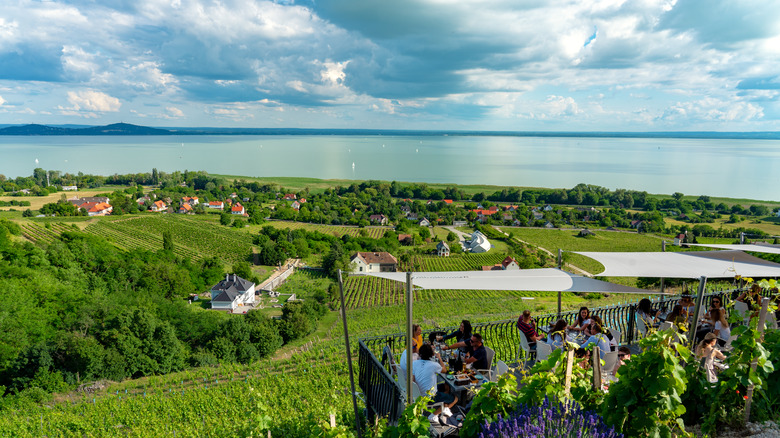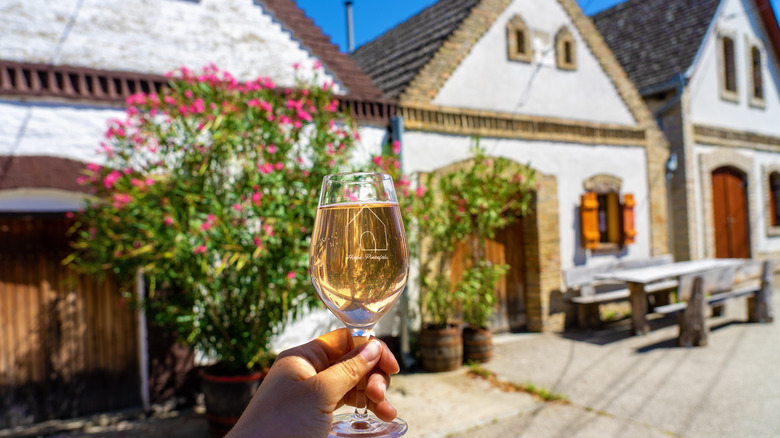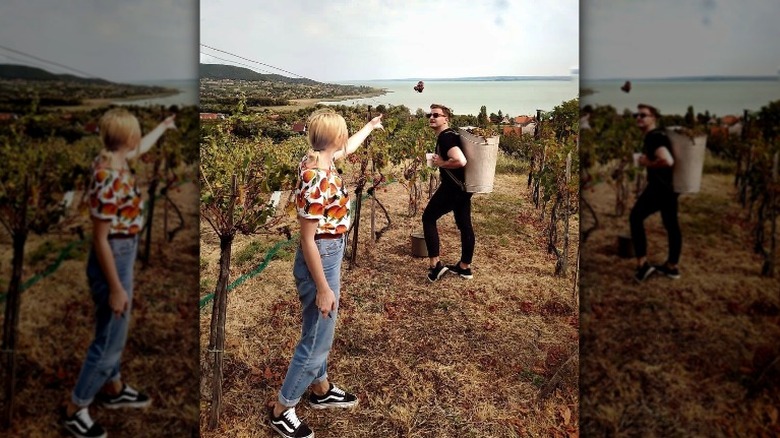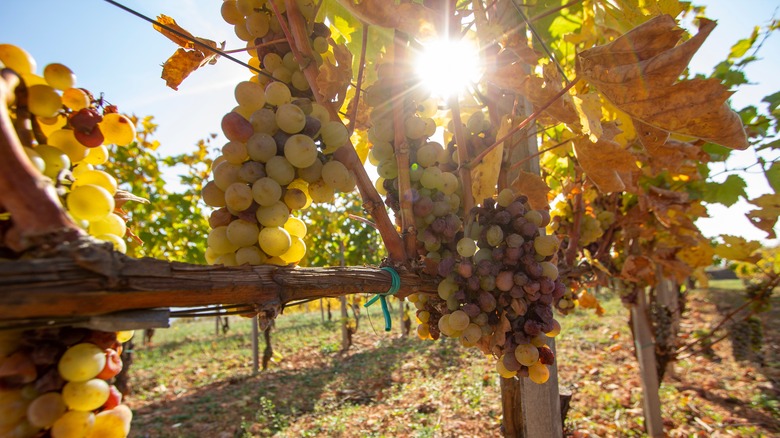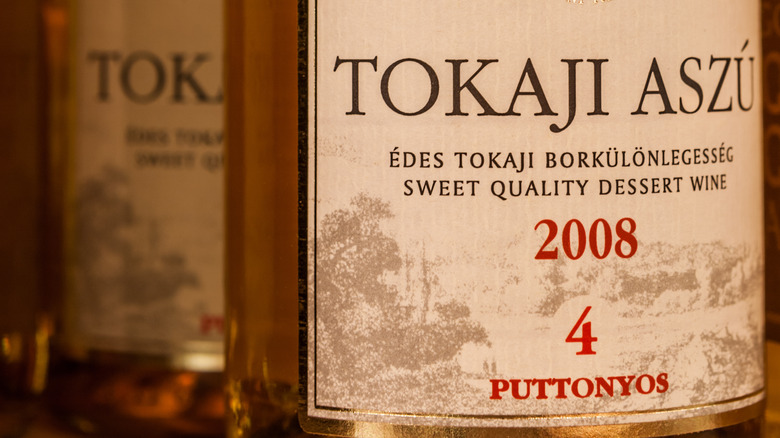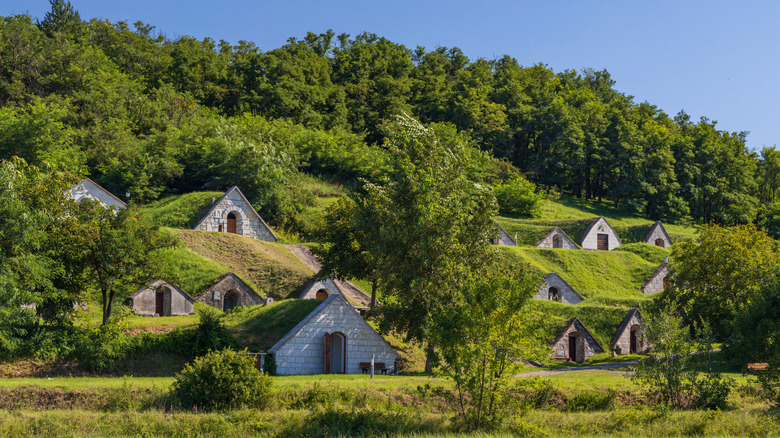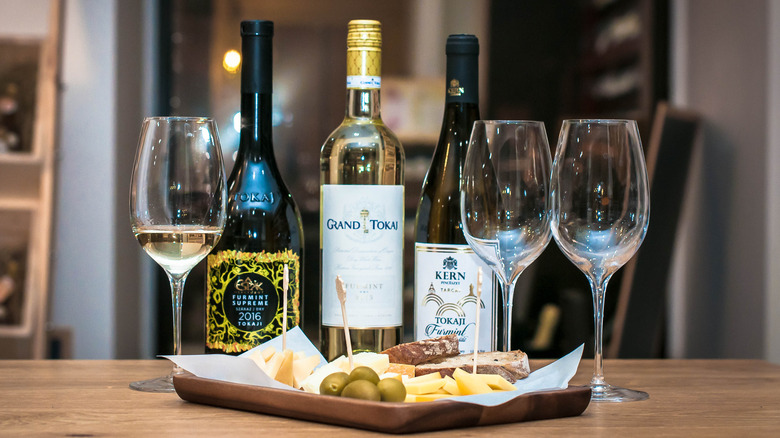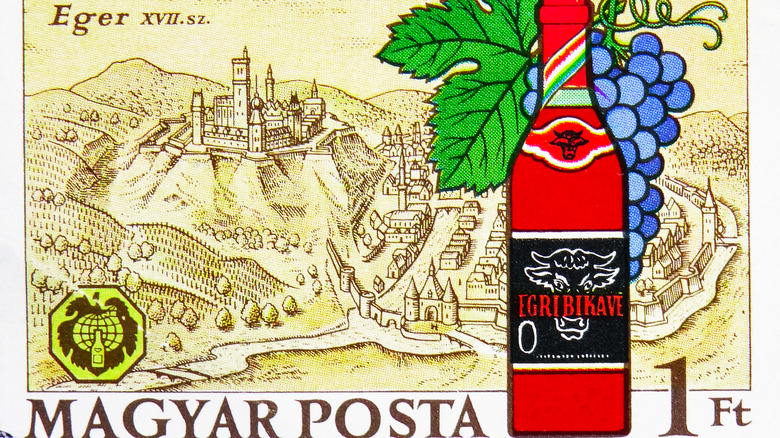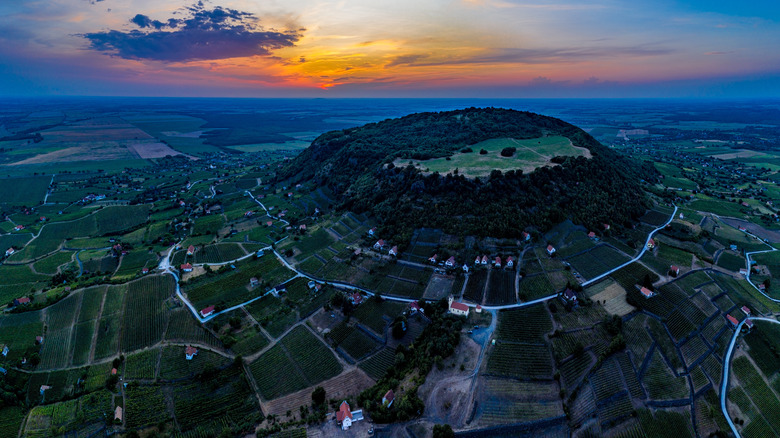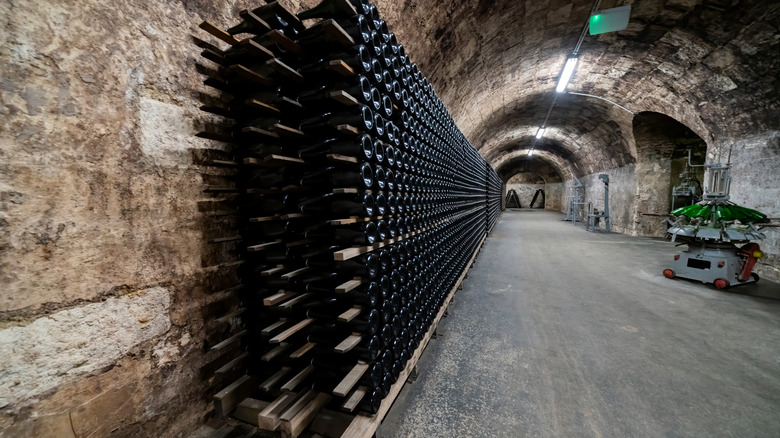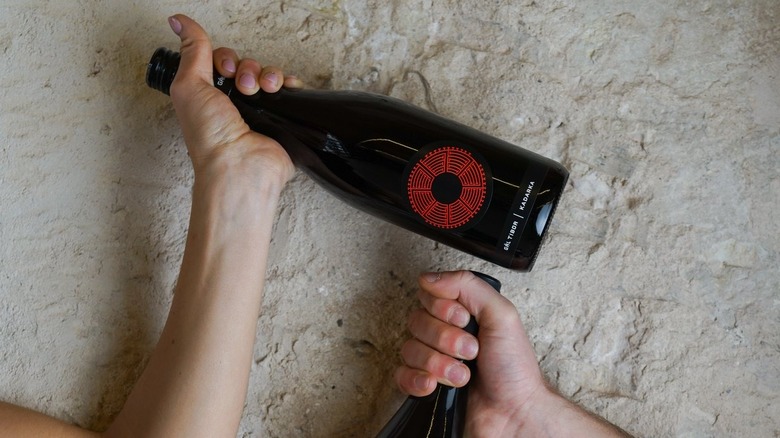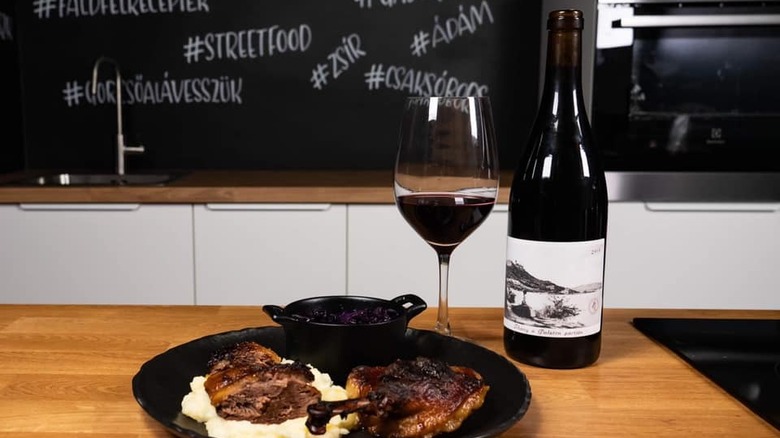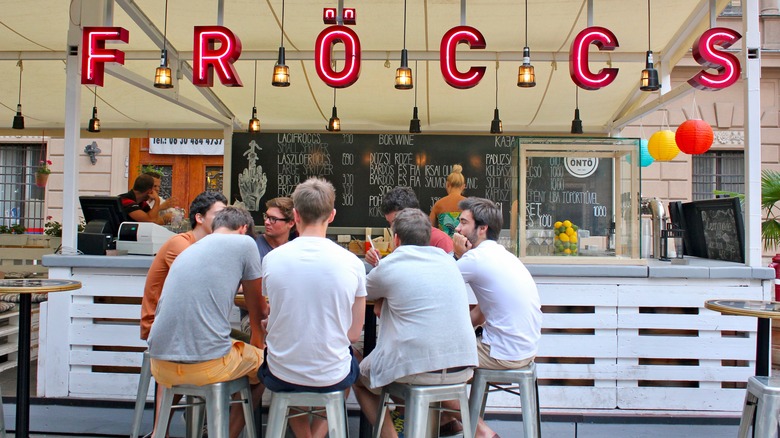The Beginner's Guide To Hungarian Wine
Hungary is home to various native Old World grapes produced by diverse wine regions that are once again gaining traction on a global scale. With new attention to the region due to the Ukraine invasion causing concerns about supply chain issues in the wine industry (not to mention climate crisis and political upheavals), we are looking to the region with renewed attention to local producers attempting to carve out space in the international wine scene.
We spoke with someone well-versed in New World, Old World, and "New, Old World" wines: Andy Seife, the wine buyer at Gramercy Wine and Spirits, an independent retailer in Manhattan that happens to be home to the largest selection of Hungarian wine in North America. "Hungary is part of a cluster of countries (mostly former Soviet bloc nations) that industry heads like myself refer to as the 'New, Old World' because their winemaking traditions are thousands of years old, but the wines are pretty much brand new to virtually all wine drinkers outside the countries in question."
Another wine expert, Sandra Guibord, CEO and Founder of Sandra's Wine Life, shared her insights into the region. She says, "With all eyes on Eastern Europe these days, the attention to turmoil should also bring our minds to the beauty and traditions of the area."
As wine lovers, we can't help but be intrigued by a roster of ancient, noble grapes native to the Carpathian Basin. What's old is new again.
Hungary has a long history of winemaking
The people we today call Hungarians are believed to have been making wine long before the prosperity and excess of the Astro-Hungarian Empire. Some estimate large-scale viniculture in Hungary developed under the control of the Roman Empire in the northwest, what is now known as Transdanubia, or the region west of the Danube River stretching from Budapest over to the Austrian border.
Hungarian chef and author George Lang writes in The Cuisine of Hungary that Roman Emperor Probus needed his soldiers to do something productive during peacetime in the Roman province. Celtic tribes are suspected to have planted the grapes there in the first place. Lang adds that the seven Magyar tribes migrated from an ancient Turkish kingdom in the 9th century and brought the knowledge of wine cultivation with them — just in time for the fall harvest.
To put that in perspective, Eater reports that Hungarian wine terminology isn't derived from Latin but can be sourced back to the 4th century B.C., which means Magyars were likely fermenting wine well before the Romans needed a side hustle. In the fifth century A.D., Hungary's many microclimates produced acclaimed wine, and by the 17th century, Hungarian wine was considered some of the best in the world, warranting the first vineyard classification system to avoid bottles from the Tokaji wine region being faked.
Why is Hungarian wine less well-known?
Despite Hungary's long history as vintners, due to a series of (many) unfortunate events, the prestige and heritage of this wine region have been mostly forgotten by our contemporaries, at least outside of the country. Politics has shaped Hungary's wine industry nearly as much as the country's old-world terroir.
Plight came with the arrival of a plant louse called phylloxera, which swept Europe due to stowaways on U.S. imports. More recently, four decades as a communist state meant that essentially one government-approved cooperative produced all of the wines exported out of the country, leading to an abundance of mono-crops and mediocre blends that valued quantity above terroir. The site explains hearty olaszrizling and kékfrankos grape varieties replaced indigenous varietals like white furmint and red kadarka vines to meet the demand.
Of course, nowadays, viticulture now is deeply impacted by the climate crisis, including pressure on the water supply. Thanks to the strain on this sub-Mediterranean region, Hungary Today reports the country is potentially looking to a less certain and necessarily more sustainable future to continue its wine production of dessert wines. Despite all geopolitical turmoil and environmental concerns, more independent Hungarian winemakers are still delivering on the region's legacy of viticulture.
Hungary's top wine regions
Hungary is home to 22 wine-growing districts and over 37 protected wine regions, notes Taste Hungary. The landlocked country has an ideal climate for making wine thanks to its dry climate with hot summers, cold winters, and an array of microclimates — situated at the same latitude as France's Champagne and Rhône wine regions. The Hungarian terroir also benefits from over two-thirds of its land being positioned on volcanic soil, leaving behind mineral-rich springs and black buttes rising up from the long-dormant lava flows.
Out of the dozens of growing districts, five main wine regions are notable for native and imported varietals: Tokaj and Eger in the northeast, Nagy Somló and Lake Balaton (also known as Badacsony) in the northwest, and Villany on the southern border near Croatia. Today, the Tokaji wine region is designated a UNESCO World Heritage site, where the dessert wine Tokaji aszú and furmint single-varietals are produced. In the north, Eger is one of the largest Hungarian wine regions, as well as the coolest, producing white and red blends, such as the aromatic, dark red wine bikáver.
Lake Balaton is the largest freshwater lake in Central Europe, flanked by black buttes formed by extinct volcanoes, including Mount Badacsony to the south with its own growing region. While southern Villány produces bold red wines, which is less common in a region with high yields of white wines, including the native kékfrankos grape and respectable takes on Hungarian Bordeaux blends using cabernet franc.
Hungary's native grape varietals
Hungary is home to nearly 100 varietals, so the wine buyer Andy Seife recommends taking it "one grape at a time." Tokaj produced the first noble rot wine in the world from its furmint and hárslevelű grapes. Hárslevelű is an ancient, native Hungarian dry white grape known for aromatics. Furmint is actually one of the country's most popular white grapes, producing the drier Tokaj furmint table wine.
For red lovers, the imported cabernet franc has taken up a second residency in the southern Villányi region. The adaptable kékfrankos is common today in many Central European countries, making deep-hued rosé and single-varietals in Hungary, as well as blending into the bikavér styles along with the native kadarka grape in the Eger region.
Lake Balaton is known for white wines with volcanic minerality, including the native grape kéknyelű, considered by Taste Hungary an embodiment of terroir wine with high acidity that matures into a rich smokey, honey, nutty flavor. A common (and often cheap) table wine for the region is olaszrizling, or Hungarian riesling, but it has taken on a life of its own as a single variety. And the rarer, native juhfark grape, pronounced "you-fark,” is a white grape grown out of the Somló region in the northwest.
How to get started with Hungarian wine
We turned to the experts about how to approach the New, Old World stocked with independent and heritage labels clamoring for your attention. Seife says, "There's something for everyone in the country. If you want a full-bodied red, go down south and pick up something from Villany, like a Cab Franc. Maybe go down to Lake Balaton, where the climate is a little bit cooler, for a dry wine. You can go to Tokaj, go to Eger — take your pick."
Seife explains Hungarian wines are "easy drinking" but with plenty of complexity for sophisticated wine enthusiasts, ranging from deep reds to orange and rose to sparkling. "If you want sweet, my goodness, this is the country that has the oldest desert one in the world," he says. "So, there's a super variance of styles."
Overwhelmed by the choices? The wine buyer recommends starting with a well-made furmint, at a good price point, because that's what Hungary is best known for, and wagers it'll stack up against your favorite riesling or chenin blanc. More of a red fan? A kadarka or kékfrankos are two native grapes you won't want to miss.
How to pronounce Hungarian wine names
It can be easy to be intimidated by the pronunciation of Hungarian wines, as can be the case with other wines and grapes from around the world. At least Hungary uses the same alphabetic writing system as English, even if Hungarian pronunciation isn't what you might expect. The good news is that knowing a few letters will go a long way.
For Hungary's most prestigious wine region, Tokaj, or Tokaji, both spellings are pronounced the same way. The wine and region are both most commonly pronounced as "toh-kai" (toe-kye), which rhymes with "eye." The letter "j" is pronounced as a "y" sound in Hungarian at the beginning of a sentence (like in English, the "y" sound tends to be flexible), so the indigenous juhfark grape is pronounced, "you-fark."
The letter "s" is pronounced with an "esh," leading to the pronunciation of the grape hárslevelű as "harsh-level-looh." While the letters "sz" is pronounced as one letter to make an "s" sound. So, the dessert wine Tokaji aszu is pronounced like toh-KAI ah-SOO. Like the multitude of Hungarian grapes, take pronunciation one letter or syllable at a time. And anyway, you had to learn how to correctly pronounce Beaujolais and Mourvedre at some point, too, right?
Tokaj aszú: The wine of kings
Tokaji aszú is the country's most famous wine, and for good reason. Tokaji is believed to have produced the first sweet white wine, made as early as 1571, garnering a UNESCO World Heritage designation due to the preservation of the region, including wine cellars carved by hand out of volcanic rock dating back to the 12th century and the tradition of viticulture continued for the last 1,000 years. The golden-hued Tokaji aszú is made from only six native varieties, including furmint, a thin-skinned and late-ripening grape with acidity, as well as hárslevelű for spice and perfume notes.
Guibord of Sandra's Wine Life explains botrytized grapes are left to the "noble rot," a growing process allowing grapes to over-ripen and shrivel on the vine, creating an "intense, luscious sweet-tart flavor." Adding complexity, Guibord says, "The traditional sweet/tart version of Tokaji, with hints of apricot, honey, and, often, savory clover, is the delectable classic pairing for foie gras or stilton blue cheese." She recommends Royal Tokaji 5 Puttonyos 2017 for its candied ginger with lemony acidity to complement spicy foods. Or, try Royal Tokaji Late Harvest 2018 with flavors of honey, litchi, and peach lifted by hints of white flowers, which she suggests serving chilled with rich blue cheese.
Seife skips convention with the rare (at least in the U.S.) Istvan Szepsy Tokaji Aszu 6 Puttonyos.
Tokaji Furmint table wine
Furmint is one of the country's most popular white grapes, with its spiritual home in the Tokaji wine region. But, not all of the wines from Tokaji are known as sweet. Wineries started making dry white wines like furmint starting in 2000 to accommodate consumer preferences. The furmint grape is the sort-of sibling of riesling and chardonnay, with a neutral taste that can speak to the terroir, whether from the volcanic soil in Tokaji or elsewhere.
Guibord says, "These dry white wines are made in the classic Burgundian style from a blend of classic French varietals and ancient Hungarian varietals, resulting in dry white wines with hints of oak and warmed apple that pair well with grilled seafood and roast chicken."
We tried the Oremus Mandolás Furmint 2018, based on recommendations from Seife and Guibord for this dry white that received 90 points from Wine Spectator. Seife described the taste as a balance between the sweet dessert wine and a true dry white. Guibord describes Mandolás Furmit as a dry Burgundian style of white dinner wine, ideal to accompany grilled fish and vegetables.
Egri Bikavér, or Bull's Blood
Egri Bikavér red wine, also known as Bull's Blood, is surrounded by myth. The wine gained notoriety as a mediocre blend during the '80s and '90s because of the Eger region cranking out bikáver wines during the country's Communist Socialist era. That memory is fading due to a return to quality independent producers reclaiming the traditional style.
The northern Eger wine region provides a cool climate for refined yet complex red wine excellent for pairing with Hungary's spice-forward dishes. Seife recommends two diverse bikavérs from Eger, a full-bodied Bolyki and an organic option from Bukolyi Marcell Wine Farm. He describes the Bolyki Egri Bikavér 2018 as a dry red wine. The Bolyki also contains plenty of alcohol and acidity on the palate, a slight pepper is a blend of six grapes, and according to the label includes 40% of the native grape kékfrankos, as well as 25% each of cabernet franc and merlot.
A small producer, Bukolyi Marcell is a family-run operation with the producer living on the estate and cultivating 14 hectares. Seife says the 2020 Kisfiam bikavér is requested by name for its "rusticity and feels a little more Old World and old school, but I think maybe a little less characteristic of the conventional style but an extremely good, serious wine." Kisfiam is aged 18 months in Hungarian oak and made with kékfrankos, syrah, and pinot noir.
Juhfark, the volcanic star
The ancient Hungarian white grape Juhfark is a mineral-driven, citrussy variety that excels when planted on the volcanic soils of the Nagy Somló region in the west of the country. Juhfark, meaning sheep's tail, also speaks of the character of its terroir and was almost lost to time until its resurgence in the 1990s. It's rarely found outside of Hungary, only adding to its mystique, and works well with robust flavors, like one of Hungary's savory soups, and fatty dishes thanks to the acidity and neutrality on the palate. It is also said to age well in the bottle.
Seife calls juhfark the "volcanic star of the region" boasting a minerality and an ability for "screechingly high" acidity. He says the fruit profile "leans very quince, or somewhere between apple and pear." He recommends this unusual wine to any fans of wines with acidity and clarity, such as from Etna, Italy, the Canary Islands, Azures, Portugal, or Santorini, Greece.
We selected the Kolonics Pinceszet Nagy-Somlói Juhfark 2019 based on Seife's recommendation for a single-varietal. It's well rated on Wine-Searcher with a 90 out of 100, and pairs well with pork, salty feta, and glass noodles with cilantro and tofu.
Hungarian sparkling wine
Sparkling wine is having a resurgence in Hungary. The Etyek region is a cool climate region near the capital of Budapest with many similarities to Champagne's climate and soil. Club Oenologique says Etyek is vying for a Protected Designation of Origin for its sparkling wines, given the name Etyeki Pezsgő (Sparkling Wines of Etyek). The wine site says these sparkling wines won't reach consumers until 2023 or later.
Fortunately, you don't have to wait to try Hungarian sparkling wines. The country's longest-running sparkling wine brand, Törley, was started by József Törley, who opened his winery in a neighborhood in Budapest in 1882 after gaining expertise in the Champagne region. Törley now imports four Etyek-Buda wines to the U.S., all at entry-level prices.
It should come as no surprise that the Tokaj wine region also produces excellent sparklers. We opted for a mouthful: Királyudvar Tokaji Pezsgö Henye Brut 2017 for a sparkling made with indigenous grapes furmint and hárslevelű, based on Seife's recommendation. The Tokaji Pezsgö (pronounced PESH-guh) is a dry sparkling wine made with berries from the Henye (HEHN-yeh) vineyard. This approachable and fresh sparkling wine blend by Domaine Királyudvar (KEE-rye-oohd-var) pairs well with white fish thanks to the fresh acidity. The brand produces a range of noteworthy blends and single-variety furmints.
Seife also recommends Sauska Brut Methode Traditionnelle, made with furmint, hárslevelű, and chardonnay, and features an espresso bean note on the finish.
Kadarka, or Noble Kadar
Nemes Kadar, or Noble Kadar, is a lighter red wine made from native Hungarian kadarka grapes. You might remember this noble red as the main grape in the Eger bikavér blend. But we like this grape all on its own. The kadarka grape is believed to have been brought by Serbians migrating from The Balkans region in the 16th century, but kadarka is now embraced as a native Hungarian vine. Yes, the phylloxera plight and communist rule put on damper on its stronghold. However, it's making a comeback, and you're going to want to get into the wine cellar door, so to speak.
This red offers an excellent introduction to the region. Seife likened it to Hungary's take on a Burgundy, as in a classic pinot noir. We highly agree with his recommendation for the Gál Tibor single-varietal Kadarka 2021 as a stellar alternative to your favorite pinot. The sour cherry notes mix well with the tannic, a hint of spice, and savory notes. Seife also noted the label found its footing after a bit of recalibrating following the inheritance of the winery by the son, who shares the name Tibor Gál, from his late father, a "Super Tuscan producer" in the 1980s. Today, the Gál Tibor winery keeps its production "as natural as possible" and is working toward the organic designation. The legacy is certainly being upheld.
Kékfrankos, Central Europe's native grape
We would be remiss to mention this native single-varietal because it is a mellow, organic red that is delicious when chilled on a hot summer day. The formerly ignored native grape is dark in color — kék means blue — and spread across the Danube river appearing across Central Europe under a variety of appellations. Hungarian kékfrankos is found in most of the country's wine regions but is most well known in Eger and Szekszárd for making classic bikavér.
Seife says the grape is notable in the northwestern Sopron wine region, which borders Austria, and produces some of the largest quantities of kékfrankos. He also recommends a producer in the northern Lake Balaton region: "Tihany a Balaton Partján." Kékfrankos Hungary Red Wine 2020 by Bökő David is harvested from Old World vines, processed without crushing and minimal agitation, then fermented on the skin in open vats. You can expect a hint of strawberries and ripe cherries, and minimal tannins — although we didn't really notice the subtle spices when chilled. At room temperature, we found the natural kékfrankos quite drinkable with a complex finish and noticed that slight zing of spice.
Hungarian rizling, a summertime go-to
A widespread grape in Central Europe, and a potential transplant (but don't believe the myth that olaszrizling is Italian). The Hungarian rizling is often used as an everyday drink or mixed with club soda for "in-between-meals" spritzer, called fröccs.
The Austro-Hungarian monarchy is said to have brought on the popularity of wine spritzers, according to Wine Sofa, and today, this white grape is found growing in all but one of the 22 wine regions in Hungary. Although widespread, the Balaton wine region is the natural home of the grape. Winemakers have even banded together to make the community label, BalatonBor (bor is the Hungarian word for wine), for production by multiple estates. Essentially this white is ideal as a summer daytime drink.
"It's notorious for being high yielding and unsophisticated, but in the right person's hands, it can be a patio summer sipper and also has orchard fruit notes, a little bit of orchard fruit and peach," Seife says. He recommended Bökő David Oslarizling 2020 from Lake Balaton for its "maritime salinity" and as one of the foundational Hungarian whites to introduce newcomers to the region. And if you're in the area, Bökő David even has a stand right on the water.
Natural and biodynamic Hungarian wines
Securing quality organic and natural wines from Hungary is relatively easy thanks to the global shift to more awareness of what goes into our food and wine. We've already touched on Bökő David Kékfrankos, a light red harvested from Old World vines, and the label's olaszrizling for an all-natural white option. Seife also recommends the organic Bukolyi Marcell Eger Kisfiam Bikavér, featuring a blend of kékfrankos, syrah, pinot noir, and cabernet franc, for its commitment to quality. The Bukolyi Marcell brand is said to be the only registered organic winery in Eger, and also produces a Hárs-Furmint Cuvée blend with native varietals furmint and hárslevelű.
Siller, pronounced "shiller," is a traditional, dark pink rosé wine thanks to longer skin contact — and one of the oldest rosé styles in the world. More Hungarian wineries are making this Old World style with a blend or single-varietal Hungarian grapes, including native kadarka grapes, for an approachable yet robust profile.
If you can get your hand on one (we couldn't!), Sauska organic rosé from the southern Villanyi region features an un-oaked blend with notes of rhubarb, pomegranate, sage, and white pepper.
Hungary's robust drinking culture
You can thank Hungary for the origins of the humble wine spritzer: Inventor Ányos Jedlik (the creator of the world's first electric motor) is said to have been the first one to devise a way to create soda water on an industrial scale in 1826, effectively leading to the beloved combination.
For better or worse, Hungary is serious about its drinking — the viniculture is Old World and historic, and the culinary traditions are built around hospitality and cafe society. Chef and author George Lang writes about his home country that the golden age of gastronomy brought about decadent restaurants in major cities, pastries and libations taking center stage at cafes and coffeehouses, and a flood of cookbooks describing the culinary wonders of Hungarian entertainment.
The tendency toward luxury and decadence hasn't disappeared from the gastronomic landscape, even if many regions are still rebuilding notoriety. Today, wine festivals to celebrate the harvest are prevalent. The end of September has long marked the wine harvest, which Lang says, required entire villages to partake in the gathering and crushing of the grapes. The ability to tour some of the country's wine regions, including the Tokaji UNESCO World Heritage site, gives a glimpse into how modern vineyards are adapting to the global stage.
